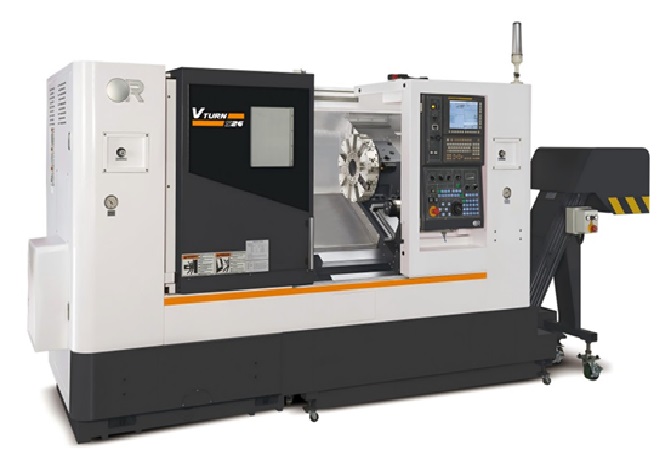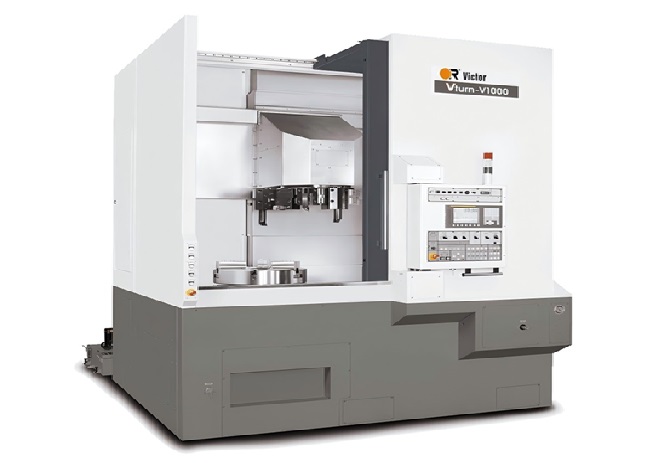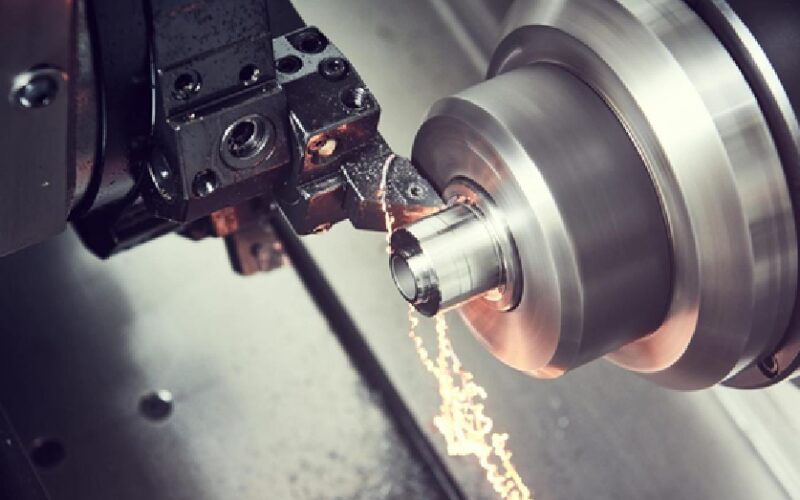CNC turning is a machining method where the material is removed from a spinning workpiece using a cutting tool. Controlled by a CNC system, it ensures high accuracy and consistency.
It is used for producing parts that are cylindrical or round in shape, making it an ideal process for components that require exact tolerances, such as shafts, bolts, and bearings.
This article explores their differences, advantages, and helps you choose the best option for your needs.
Types of CNC Turning
Vertical and horizontal CNC turning are the two main varieties of CNC turning. The main difference between them lies in the orientation of the spindle – either vertical or horizontal, which affects how the machine handles the workpiece and the material removal process.
Horizontal CNC Turning

Horizontal CNC turning is the most common type and is recognized for its versatility.
In horizontal turning, the spindle is oriented horizontally, and the workpiece is mounted horizontally on a rotating spindle. To remove material from the spinning part, the cutting tool travels along the X and Z axes.
Advantages of Horizontal CNC Turning
- Versatility: Horizontal CNC lathes can handle a wide variety of part sizes and shapes, making them ideal for general-purpose machining. They have the ability to produce medium-sized and small-sized parts.
- Ideal for Long, Slender Parts: Horizontal CNC turning is particularly efficient when it comes to producing long, slender parts, such as shafts, pipes, and axles. The horizontal orientation provides more stability and support along the length of the workpiece.
- Efficient Chip Removal: Gravity helps with chip evacuation in horizontal CNC turning, as the chips fall away from the workpiece naturally. This increases machining efficiency and helps maintain a clear cutting area.
- Operator Familiarity: Horizontal turning is widely used, and operators are generally more familiar with these machines, which reduces the learning curve and improves productivity.
Disadvantages of Horizontal CNC Turning
- Larger Footprint: Horizontal CNC turning tends to take up more floor space in a workshop, which can be an issue for businesses with limited space.
- Limited for Heavy Workpieces: While horizontal CNC turning is highly versatile, it may not be the best choice for handling large or heavy workpieces.
Vertical CNC Turning

Vertical CNC turning machines have a spindle oriented vertically, with the workpiece mounted on a rotating table. This configuration allows gravity to assist in holding the workpiece, making it particularly useful for large, heavy parts.
Vertical CNC turning is quite popular in industries where large-dimension, heavy-duty, bulky components need to be machined.
Advantages of Vertical CNC Turning
- Handling Large, Heavy Parts: Vertical CNC turning machines are better suited for large, heavy workpieces. The vertical orientation helps gravity hold the part securely in place, reducing the risk of part deflection and improving machining accuracy.
- Smaller Footprint: Despite being able to handle large workpieces, vertical CNC turning machines typically have a smaller footprint compared to horizontal machines. This makes it perfect for workshops with limited floor space.
- Increased Stability for Large Parts: With the workpiece securely clamped in a vertical position, vertical CNC lathes offer greater stability when working on large parts. This ensures more precise custom CNC machining of heavy-duty components.
- Reduced Operator Fatigue: Loading and unloading heavy parts is easier in vertical CNC turning machines, as gravity assists in the process. This reduces operator fatigue and can improve overall productivity.
Disadvantages of Vertical CNC Turning
- Less Versatile: Vertical CNC turning machines are less versatile than horizontal CNC lathes. They are primarily used for machining large-diameter parts and may not be suitable for smaller or more intricate parts.
- Chip Accumulation: Chips tend to accumulate on the workpiece in a vertical setup, which may interfere with the cutting process. Frequent chip removal or advanced chip management systems are often required in vertical CNC turning.
Main Difference Between Vertical and Horizontal CNC Turning
Determining which choice is ideal for your business requires an understanding of the main distinctions between vertical and horizontal CNC turning machines.
| Feature | Horizontal CNC Turning | Vertical CNC Turning |
| Spindle Orientation | Horizontal spindle | Vertical spindle |
| Best For | Long, slender parts; general-purpose machining | Large, heavy parts with large diameters |
| Chip Removal | Efficient chip removal, gravity assists | Chips tend to accumulate on the workpiece, requiring more frequent cleaning |
| Floor Space | Larger footprint | Smaller footprint for handling large parts |
| Workpiece Handling | More operator involvement for heavy parts | Gravity helps secure large, heavy workpieces |
| Workpiece Size | Ideal for medium to long parts | Best for large-diameter, heavy workpieces |
| Stability | Less stable for large, heavy parts | Increased stability due to gravity-assisted clamping |
| Versatility | More versatile for various part sizes and shapes | Suited for specialized, large-part machining |
1. Productivity Consideration
The productivity of vertical and horizontal CNC turning machines varies depending on the type of work being done, the size of the workpieces, and the overall production volume. Here are some key productivity factors to consider:
2. Part Size and Weight
Vertical CNC turning machines excel in handling large, heavy parts such as turbine housings, gearboxes, and engine casings. The vertical orientation provides greater stability and precision for machining large-diameter components.
Horizontal CNC turning machines are better suited for long, slender parts like shafts and pipes. They offer greater support along the length of the workpiece, ensuring high precision during machining.
3. Chip Management
Horizontal CNC turning machines have the advantage when it comes to chip removal. Gravity facilitates the removal of chips from the cutting area, minimizing downtime and keeping them out of the way of the machining operation.
Vertical CNC turning machines, on the other hand, may struggle with chip accumulation on the workpiece. Frequent cleaning or advanced chip evacuation systems are often necessary to maintain productivity.
4. Setup and Changeover
Horizontal CNC turning machines are more versatile and can be reconfigured easily for different types of parts, making them suitable for businesses that work with a wide variety of components.
Vertical CNC turning machines are often specialized for repetitive, high-precision tasks involving large parts. While they offer increased stability for heavy-duty machining, they are less adaptable to frequent changes in part design.
Applications
Both vertical and horizontal CNC turning machines have applications across a range of industries, depending on the type of parts being produced.
Horizontal CNC Turning Applications
- Automotive Industry: Horizontal CNC turning machines are commonly used to produce automotive components like crankshafts, axles, and transmission parts.
- Aerospace: Horizontal lathes are ideal for machining long, slender parts such as landing gear components, structural supports, and fuel system components.
- General Machining: Horizontal CNC turning machines are versatile enough to produce a wide range of cylindrical parts, including screws, fittings, and small to medium-sized shafts.
Vertical CNC Turning Applications
- Heavy Equipment Manufacturing: Vertical CNC turning machines are ideal for producing large, heavy components such as turbine housings, flywheels, and gearboxes.
- Aerospace: Vertical lathes are commonly used for machining large-diameter aerospace components such as engine casings and structural rings.
- Energy Sector: Vertical CNC turning machines are often used to produce large components for power plants, wind turbines, and other heavy-duty machinery.
Which CNC Turning Type Suits Your Business Best?
The decision between vertical and horizontal CNC turning machines depends on the specific requirements of your business, the types of parts you produce, and the available floor space in your workshop. Here are some key considerations:
- If your business produces a variety of part sizes and shapes, horizontal CNC turning machines offer more versatility and are suitable for a wide range of workpieces.
- If your business specializes in large, heavy parts, vertical CNC turning machines provide greater stability and ease of handling, making them ideal for industries such as aerospace, energy, and heavy equipment manufacturing.
- For businesses with limited floor space, vertical CNC turning machines are often a better choice, as they have a smaller footprint despite handling large parts.
- For high-volume production of long, slender parts, horizontal CNC turning machines are more efficient and offer better chip management, resulting in higher productivity.

